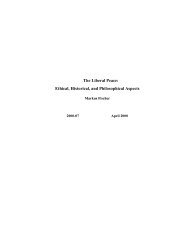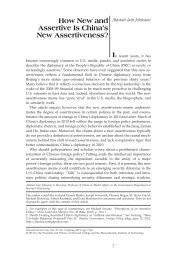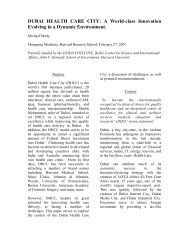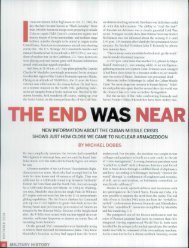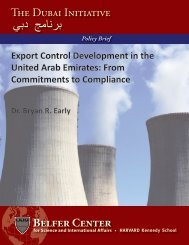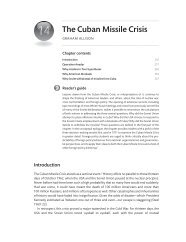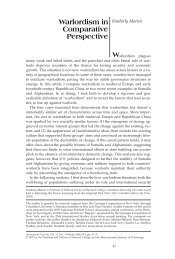Interim Storage of Spent Nuclear Fuel - Woods Hole Research Center
Interim Storage of Spent Nuclear Fuel - Woods Hole Research Center
Interim Storage of Spent Nuclear Fuel - Woods Hole Research Center
Create successful ePaper yourself
Turn your PDF publications into a flip-book with our unique Google optimized e-Paper software.
16<br />
storage allow it to begin to catch up with cask storage. Figure<br />
2.3 shows the breakdown <strong>of</strong> estimated discounted costs<br />
<strong>of</strong> pool and cask storage at several sizes. 30<br />
For both the United States and Japan, it should be<br />
noted that costs <strong>of</strong> the variety <strong>of</strong> benefits that may be paid<br />
to the local community to build public acceptance and gain<br />
government approvals are not included in these totals.<br />
These costs will vary from zero to significant additions to<br />
the total, depending on the circumstances <strong>of</strong> the individual<br />
case.<br />
The costs <strong>of</strong> interim storage <strong>of</strong> spent fuel are quite<br />
modest when compared to either reprocessing costs (more<br />
than $900/kgHM in current European facilities, even after<br />
their initial capital costs have been paid, and more for<br />
Japan’s Rokkasho-mura facility) or the costs <strong>of</strong> direct disposal.<br />
This is to be expected, since interim storage <strong>of</strong>fers<br />
only a temporary solution, and in virtually all industries,<br />
permanent solutions are more expensive than temporary<br />
ones. From a strictly economic point <strong>of</strong> view, interim storage<br />
pays for itself by allowing the reactor operator to discount<br />
the costs <strong>of</strong> either reprocessing or direct disposal <strong>of</strong><br />
the spent fuel into the future. For example, at a discount<br />
rate <strong>of</strong> 5%, a reprocessing cost <strong>of</strong> $1000/kgHM need only be<br />
postponed for 5 years to save over $200/kgHM—somewhat<br />
more than the lifetime dry cask storage cost estimated<br />
in Japan. Much the same could be said, <strong>of</strong> course, with<br />
respect to using interim storage to postpone and thus discount<br />
the costs <strong>of</strong> direct disposal. The point is not that permanent<br />
solutions should be postponed, but that at low<br />
INTERIM STORAGE OF SPENT NUCLEAR FUEL<br />
cost, interim storage provides the flexibility to implement<br />
permanent solutions at an optimized timing and pace.<br />
Nonproliferation and Safeguards<br />
Aspects <strong>of</strong> Dry <strong>Storage</strong><br />
<strong>Spent</strong> nuclear fuel contains a small percentage <strong>of</strong> plutonium,<br />
and therefore must be appropriately secured and safeguarded.<br />
Indeed, more than two-thirds <strong>of</strong> all the plutonium<br />
that now exists, over 1,100 tonnes, is in spent nuclear fuel,<br />
in dozens <strong>of</strong> countries around the world. 31 The reactorgrade<br />
plutonium in typical spent fuel would not be the preferred<br />
material for making nuclear weapons, but once separated<br />
from the spent fuel, it is weapons-usable, whether by<br />
unsophisticated proliferators or by advanced nuclear<br />
weapon states. 32 Fortunately, providing appropriate safeguards<br />
and security for spent fuel in storage is a straightforward<br />
task.<br />
In spent fuel, plutonium is embedded in massive,<br />
intensely radioactive fuel assemblies which would be rather<br />
difficult to steal and recover plutonium from—and which<br />
are easy to count and monitor. To get enough plutonium for<br />
a bomb would require removing 1-2 roughly 670 kilogram<br />
fuel assemblies for a pressurized water reactor (PWR), or 3-<br />
4 roughly 250 kilogram assemblies from a boiling water<br />
reactor (BWR)—and such removal would be quite easy to<br />
detect. Thus, the security hazard posed by plutonium in<br />
spent fuel is much less than the hazard posed by separated<br />
plutonium that is directly usable in nuclear weapons. 33<br />
30 MITI, Toward Implementation <strong>of</strong> <strong>Interim</strong> <strong>Storage</strong> for Recycled <strong>Fuel</strong> Resources, op. cit.<br />
31 See David Albright and Mark Gorwitz, “Plutonium Watch: Tracking Civil Plutonium Inventories: End <strong>of</strong> 1999” (Washington,<br />
DC: Institute for Science and International Security, October 2000). Albright and Gorwitz provide an estimate <strong>of</strong><br />
1,065 tonnes in spent fuel as <strong>of</strong> the end <strong>of</strong> 1999, but this amount increases by some 60 tonnes per year, so the total at the<br />
end <strong>of</strong> 2000 was over 1,100 tonnes.<br />
32 At the low end <strong>of</strong> the spectrum <strong>of</strong> sophistication (capabilities that might be available to a less developed state or, conceivably,<br />
a particularly well-organized terrorist group), reactor-grade plutonium can be used to make an explosive with a<br />
reliable, assured yield in the kiloton range (meaning a radius <strong>of</strong> destruction one-third that <strong>of</strong> the Hiroshima bomb) using<br />
technologies no more sophisticated than those used in the first nuclear weapons. At the high end <strong>of</strong> the spectrum <strong>of</strong> sophistication,<br />
advanced weapon states such as the United States and Russia could make weapons from reactor-grade plutonium<br />
having yield, reliability, weight, and other characteristics generally comparable to those <strong>of</strong> weapons made from weapongrade<br />
plutonium. For an <strong>of</strong>ficial declassified statement making this point, see Nonproliferation and Arms Control Assessment<br />
<strong>of</strong> Weapons-Usable Fissile Material <strong>Storage</strong> and Excess Plutonium Disposition Alternatives, DOE/NN-0007 (Washington, DC: U.S.<br />
Department <strong>of</strong> Energy, January 1997), pp. 37-39.<br />
33 For a discussion <strong>of</strong> how difficult it would be for states and non-state actors to recover plutonium from spent fuel, see<br />
Committee on International Security and Arms Control, Panel to Review the <strong>Spent</strong>-<strong>Fuel</strong> Standard for Disposition <strong>of</strong> Excess<br />
Weapon Plutonium, U.S. National Academy <strong>of</strong> Sciences, The <strong>Spent</strong>-<strong>Fuel</strong> Standard for Disposition <strong>of</strong> Excess Weapon Plutonium:<br />
Applications to Current DOE Options (Washington, DC: National Academy Press, 2001), and Nonproliferation and Arms Control<br />
Assessment <strong>of</strong> Weapons-Usable Fissile Material <strong>Storage</strong> and Excess Plutonium Disposition Alternatives, op. cit., pp. 52-60.




